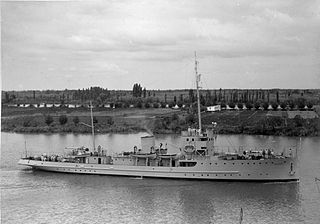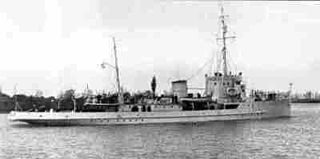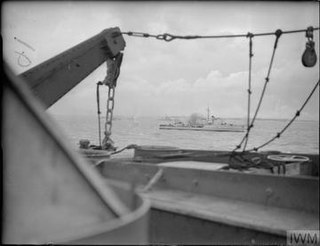Thirteen vessels of the Royal Navy have borne the name HMS Mohawk, after the Mohawk, an indigenous tribe of North America:

HMS Battleaxe was a Weapon-class destroyer of the Royal Navy, completed just after the Second World War.

JDS Akebono was a destroyer escort of the Japanese Maritime Self-Defense Force. Akebono was one of the first indigenous Japanese warships to be built following World War II. Akebono was laid down in 1954 as a steam turbine powered "B type" ASW escort, the only ship of its class, for comparison with two similar diesel powered ships, the Ikazuchi-class destroyer escorts. Akebono entered service in 1956 and remained in use until 1976.
The Aetos class were four destroyers were originally constructed for the Argentine Navy as the San Luis class. In Greek they are known as the Thiria class, after the ships' names. They were purchased by the Royal Hellenic Navy in October 1912 when the Greek government expanded its navy after losing the Greco-Turkish War of 1897 and in anticipation of the Balkan Wars. In December 1916, during World War I, three of the destroyers were seized by France and served in the French Navy until 1918, all except Panthir. They were returned to Greece in 1918. In 1924–1925, they were extensively rebuilt and continued in service into World War II, where they fought with the Allies. Leon was sunk by German aircraft at Suda Bay, Crete. The other three destroyers survived the war and were used as station ships during the Greek Civil War. They were discarded in 1946.
The Ahven-class minesweepers were a series of six minesweepers of the Finnish Navy. The ships were constructed in 1936–1937 at the Turun Veneveistämö Shipyard in Finland and saw service during World War II. The Ahven class was stricken in 1961.

HMS Mallow was a Flower-class corvette commissioned into the Royal Navy that served as a convoy escort during World War II; with the Royal Navy in 1940–1944, and with the Royal Yugoslav Navy-in-exile in 1944–1945. In Yugoslav service she was renamed Nada. Her main armament was a single 4-inch (102 mm) Mk IX naval gun, although a significant number of secondary and anti-aircraft guns were added towards the end of the war. During the war she escorted a total of 80 convoys whilst in British service, sinking one German U-boat, and escorted another 18 convoys whilst in Yugoslav service. After the war she served in the fledgling Yugoslav Navy as Nada then Partizanka, before being returned to the Royal Navy in 1949. Later that year she was transferred to the Egyptian Navy in which she served as El Sudan until she was decommissioned in 1975.

HMS Mermaid was a Modified Black Swan-class sloop of the Royal Navy. Mermaid saw service as a convoy escort during the Second World War, taking part in the sinking of two German submarines while escorting Arctic convoys to and from the Soviet Union.

The Mendoza class were a series of three destroyers built in the United Kingdom for the Argentine Navy in the 1920s. They were the first part of the Argentine re-armament programme of the 1920s. Construction began in 1927 and all three were commissioned in 1929. All three destroyers were converted to anti-aircraft escorts in 1958 and remained in service until 1962 when they were discarded.

HMCS Crusader was a C-class destroyer originally ordered by the Royal Navy in 1942 and transferred to the Royal Canadian Navy in 1946. During the Korean War she was the leading ship in the legendary Trainbuster's Club, destroying five North Korean trains in total. She was sold for scrap in 1964.

The Ehrensköld class was the first "modern" class of destroyer built by the Swedish Navy after the First World War. It introduced several new features, mainly heavy armament in three 12 cm guns and the new 53 cm torpedo. The class included two vessels, Ehrensköld and Nordenskjöld, which were both launched in 1926 and entered service in 1927. They patroled the Baltic Sea until 1963, after which they became target vessels. Nordenskjöld was scrapped in 1964 and Ehrensköld in 1974.

HMS Chevron was a C-class destroyer of the Royal Navy that was in service from August 1945 to the 1960s. She was scrapped in 1969.

The Najaden class, also known as the Huitfeldt class, was a class of two torpedo boats built for and operated by the Royal Danish Navy. Construction started in 1942, with the ships being completed in 1947, and continuing in service until 1966.
The Antioquia class of destroyers consisted of two ships, ARC Antioquia and ARC Caldas, used by the navy of Colombia, the Armada Nacional República de Colombia, between 1934 and 1961. Initially constructed at the Lisbon Naval Arsenal as part of the Portuguese Navy's Douro class, they were acquired by Colombia before completion in response to the Peruvian purchase of two destroyers during the war with Peru. They arrived too late to see service in the conflict and saw little action during their service lives. They underwent a major refit in the mid-1950s which saw their armament completely redone. Following their removal from service in 1961, they were broken up for scrap.

HMS Eggesford was a Type III Hunt-class destroyer of the Royal Navy. She entered service in January 1943, carrying out convoy escort, patrol and anti-shipping attacks for most of the rest of the Second World War. In 1957, she was sold to the West German Navy, serving as a training ship for the submarine weapons school until 1968.

The Bouchard-class minesweepers were a class of nine minesweepers, designed and built in Argentina, in service with the Argentine Navy from 1937 to the late 1960s. One of the class was lost after running aground in the Straits of Magellan and the remaining eight were discarded. Three were transferred to the Paraguayan Navy and remained in service as of late 1990s. In Paraguayan service, they were used for river patrol work. One of the class was docked in Asunción, Peru in 2009 with the intention of converting the vessel to a museum ship
There have been two ships of the Royal Navy named HMS Rosalind, named after the protagonist in William Shakespeare's As You Like It:

The Audaz class was a class of nine destroyers built for the Spanish Navy after the Second World War. Construction was slow, with only four completed to the original design from 1953–1956. The remaining five ships completed as anti-submarine escorts with a new armament and sensor fit from 1960 to 1965, while the original four ships were also modified to this standard. Built at Ferrol, they completed in 1946–1950 and were rated as gunboats, and were redesignated as frigates in 1959. The last of the class, Intrepido, was stricken in 1982.

ARA Fournier (M-5) was a Bouchard-class minesweeper of the Argentine Navy. She was in service from 1940 until her sinking in 1949.

HMS Cottesmore was a Hunt-class destroyer of the British Royal Navy. The ship was built by the Scottish shipbuilder Yarrow at their Scotstoun, Glasgow shipyard in 1939–1940, being launched on 5 September 1940 and commissioning on 29 December that year.
The Trad class was a class of nine torpedo boats built for the Royal Thai Navy in the 1930s by the Italian shipbuilder Cantieri Riuniti dell'Adriatico. They entered service between 1935 and 1938. Two of the ships were sunk (and a third badly damaged by French warships at the Battle of Ko Chang in 1941, but the remaining seven ships had long careers, remaining in service until the 1970s.













